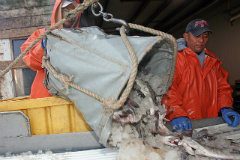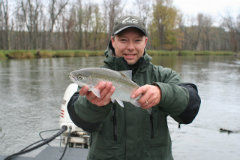
The sustainable seafood industry promises to deliver seafood that does not significantly deplete populations or harm the environment; “South African Hake fishermen” (CC BY-NC-ND 2.0) by Marine Stewardship Council
Unilever and World Wildlife Fund created the Marine Stewardship Council after the 1992 Canadian cod fishing ban. The government called for the cod fishing ban after a severe collapse in the stock's population. Due to the moratorium, 35,000 people became unemployed. The damage to the economy as well as the environment led to the creation of the sustainable seafood industry.
Source — NPR's under the label: sustainable seafood series
Several organizations assess seafood for sustainability. We will focus on 3 high-profile certification organizations:
Each organization assesses different seafood types and has different tools to help you make a sustainable seafood choice.
| Do they... | ASC | MSC | Seafood Watch |
|---|---|---|---|
| assess farmed seafood? | Yes | No | Yes |
| assess wild caught seafood? | No | Yes | Yes |
| assess local species that are not widely traded? | No | Yes | Yes |
| assess seafood suppliers? | Yes | Yes | Yes, but it is less formal and suppliers are called “Business Partners”. |
| have an app? | No, but you can search their sustainable seafood list here. | Yes | Yes |
| have a label? |  |
No, but they have a list of other organizations' labels that they approve. |
Download a table of the species that each organization certifies.
The sustainable seafood industry has controversies related to their certification decisions. The MSC has the most controversies because it is the most extensive sustainability certification body. We could not find specific controversies about the ASC, which is the newest and least extensive organization. Also, the ASC is the only organization we reviewed that exclusively certifies farmed seafood.
The controversies considered below are for specific instances of sustainability certification. We do not discuss the overall merits and drawbacks of the sustainable seafood industry.

Swordfish fisheries using longline boats catch about 5 blue sharks for every 1 swordfish. Fisheries release the sharks, but one study shows up to 35% of them die within days. Thus, Canadian fishing boats kill about 2 blue sharks for every 1 swordfish they catch.
The MSC confused many researchers when it certified the Canadian swordfish industry. These researchers think sustainability certification is premature given uncertainty and debate over the data. They believe the only swordfish capturing method proven to be sustainable is harpooning. However, longline boats catch about 90% of Canadian swordfish.
The Canadian swordfish industry cites other studies showing the overall blue shark population is stable. These studies' researchers acknowledge their data is uncertain. However, studies showing blue shark population decline focus on a limited region and may not be considered representative.
The MSC says that swordfish caught in Canadian waters harm less blue sharks than fisheries of other countries. Thus, Canadian swordfish are a more sustainable alternative than swordfish from elsewhere. Also, the MSC claims the number of sharks harmed is within ecological limits.
Source — NPR's under the label: sustainable seafood series

The MSC removed 3 North Sea and West of Scotland haddock fisheries from their “green” list because of falling stock levels. The industry believes removal from the “green” list does not acknowledge their work to rebuild the stock.
The MSC responds that the fisheries have not actually been de-certified. The fisheries remain on the sustainability certification list because they are following procedure to rebuild the fish population. Instead, the MSC lists haddock from these fisheries at a sustainability level lower than “green”.
Source — BBC's Scottish North Sea haddock article

Seafood Watch has listed wild caught steelhead from Washington's Olympic Peninsula as a “good alternative” fish. The relatively positive listing comes despite data showing the fish population has declined by as much as half since 1980. In 2016, 2 rivers showed the lowest returns of the fish on record.
Source — The Venturing Angler article
Seafood Watch admits the number of fish returning to the rivers for the summer run is unknown. However, the organization says the winter-run data shows the population is being sustained. Seafood Watch also recognizes threatened bull trout bycatch, which is why steelhead is not listed as a “best choice”.
Source — Washington Rainbow (Steelhead) Trout Seafood Watch Report
Sustainable seafood organizations may certify the chain of custody in addition to seafood farms and/or wild caught fisheries.
| Do they certify... | ASC | MSC | Seafood Watch |
|---|---|---|---|
| fish farms? | Yes | No | Yes |
| fish farm suppliers? | Yes | No | No |
| wild caught fisheries? | No | Yes | Yes |
| chain of custody? | ASC and MSC developed a joint chain-of-custody certification. Certifying the chain of custody ensures sustainability from the point of seafood harvest through the point of sale. | No | |
Each organization uses similar methods to develop sustainable seafood standards, including consulting stakeholders such as:
| ASC | MSC | Seafood Watch | |
|---|---|---|---|
| Who develops the standards? | The website does not identify which members develop standards. However, the ASC includes the following branches — Commercial, Communications, Development, Finance, Logo Licensing, Programme Integrity, Standards & Science. | A Steering Committee consisting of internal MSC members from various disciplines. | Scientists who review applicable documents while also holding conversations with fishery and fish farm experts. |
| When are other industries consulted? | Before standards are developed. Development of initial standards included 8 round-table talks with over 2,000 participants. | During review periods, 2 rounds for new standards and 1 round for revised standards. | Before and after standards are developed. Scientists consult with experts when developing standards. They then circulate the standards for review by academia, government, and the seafood industry. |
| How often are the standards reviewed? | Every 3-5 years. | Every 3-5 years. | Every 3-4 years. |
Each organization has similar sustainability certification standards for environmental impacts. However, the ASC is the only organization that adds social responsibility to the list.
The table below gives a summary of wild caught seafood fishery standards. Farmed seafood standards are addressed in the next section.
| Do they have standards for... | ASC | MSC | Seafood Watch |
|---|---|---|---|
| managing fisheries effectively? | N/A | Fishery must have a management system to maintain sustainability and comply with applicable laws. | Fishery is managed to support long-term production. |
| minimizing impacts? | N/A | Operations must not damage the fishery's ecosystem. | Fishing methods should minimize bycatch and avoid harmful impacts to the ecosystem. |
| sustaining fish stocks? | N/A | Fishing is maintained at a sustainable level; depleted stocks can be rebuilt within a specified timeframe. | Seafood stock is healthy, abundant, and maintained at acceptable levels. |
The table below gives a summary of farmed seafood standards. Wild caught seafood standards are addressed in the previous section.
| Do they have standards for... | ASC | MSC | Seafood Watch |
|---|---|---|---|
| community relations? | Farm makes records available to the public and responds to complaints. | N/A | N/A |
| data availability? | Farm provides evidence that it complies with all applicable laws. | N/A | Farm operations are well researched and data is made available to the public. |
| disease? | Farm is managed to reduce disease outbreak to the ecosystem and other farms when stock is transported. | N/A | Farm has a low risk of disease outbreak. |
| energy? | Farm conducts an energy audit and makes records available. | N/A | N/A |
| escape? | Farm responsibly introduces exotic species, uses native farm seed, and is designed to minimize fish escapes. | N/A | Farm stocks native species and is designed to minimize fish escapes. |
| feed? | Farm uses feed from a well-managed source. | N/A | Farm uses feed that is sustainable, has no net protein loss, and has a small footprint. |
| freshwater use? | Farm records how much freshwater it uses. | N/A | N/A |
| habitat functions? | Farm activity does not have a negative impact on habitat for threatened or endangered species. | N/A | Adjacent habitat provides the same level of functions (e.g., flood control) as it did before the farm was built. |
| impacts to outside ecosystems? | Farm minimizes the amount of pollutants reaching the ecosystem. | N/A | Farm minimizes the amount of pollutants reaching the ecosystem. |
| social and cultural responsibility? | Farm
|
N/A | N/A |
| solid waste disposal? | Farm has a recycling program. | N/A | N/A |
The ASC and the MSC have joint standards for certifying seafood suppliers. Seafood Watch does not have chain-of-custody standards. ASC/MSC chain-of-custody standards are summarized below:
Read more about the ASC/MSC chain-of-custody standards.
Sustainability for seafood typically refers to not overfishing or harming the ecosystem. A more inclusive approach integrates social, environmental, and financial factors (also known as people, planet, and profit) to achieve a balance. This concept is called the triple bottom line.
The ASC is the only organization we have discussed that incorporates the triple bottom line. Their seafood farm standards include social considerations alongside environmental planning. Since the farm is in business to make money, the economic factor is implied.